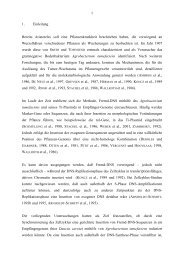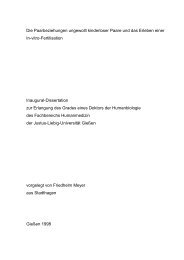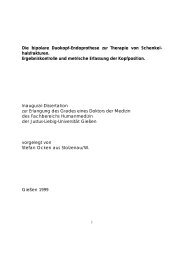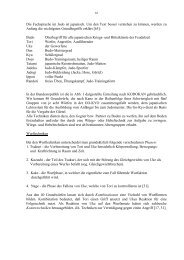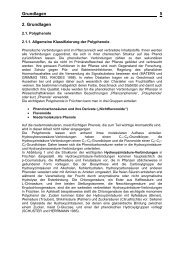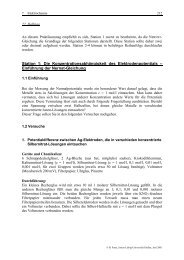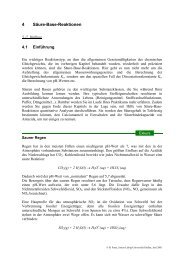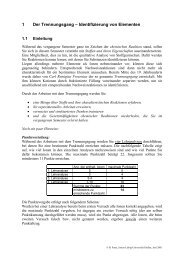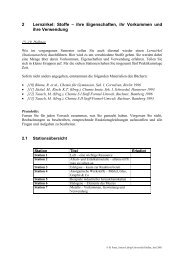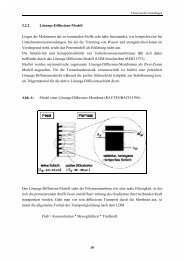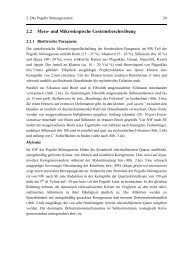Effects of diabaticity on fusion of heavy nuclei in the dinuclear model ...
Effects of diabaticity on fusion of heavy nuclei in the dinuclear model ...
Effects of diabaticity on fusion of heavy nuclei in the dinuclear model ...
Create successful ePaper yourself
Turn your PDF publications into a flip-book with our unique Google optimized e-Paper software.
observed <strong>the</strong> rapid fall-<str<strong>on</strong>g>of</str<strong>on</strong>g>f <str<strong>on</strong>g>of</str<strong>on</strong>g> <strong>the</strong> evaporati<strong>on</strong> residue cross secti<strong>on</strong> (about four orders <str<strong>on</strong>g>of</str<strong>on</strong>g> magni-<br />
with <strong>in</strong>creas<strong>in</strong>g Z <str<strong>on</strong>g>of</str<strong>on</strong>g> <strong>the</strong> compound nucleus ([4], [7], [8]). The measured cross secti<strong>on</strong> <str<strong>on</strong>g>of</str<strong>on</strong>g><br />
tude)<br />
producti<strong>on</strong> <str<strong>on</strong>g>of</str<strong>on</strong>g> <strong>the</strong> element with Z=112 was 1 <strong>the</strong> +1.3<br />
−0.6 pb.<br />
The usual extrapolati<strong>on</strong>s <str<strong>on</strong>g>of</str<strong>on</strong>g> exist<strong>in</strong>g data <strong>on</strong> <strong>the</strong> syn<strong>the</strong>sis <str<strong>on</strong>g>of</str<strong>on</strong>g> elements 110-112 <strong>in</strong>dicate that<br />
to reach still heavier elements will require orders <str<strong>on</strong>g>of</str<strong>on</strong>g> magnitude <strong>in</strong>creases <strong>in</strong> accelerator beam<br />
currents and new target technologies. It has proven difficult to proceed bey<strong>on</strong>d element 112<br />
us<strong>in</strong>g cold fusi<strong>on</strong> reacti<strong>on</strong>s [9]. However, <strong>the</strong> syn<strong>the</strong>sis <str<strong>on</strong>g>of</str<strong>on</strong>g> <strong>the</strong> element 293 118 by cold fusi<strong>on</strong><br />
reacti<strong>on</strong> <str<strong>on</strong>g>of</str<strong>on</strong>g> 86 Kr with 208 Pb <strong>in</strong> <strong>the</strong> LBL [10] has recently been reported. The producti<strong>on</strong> cross<br />
was 2.2 secti<strong>on</strong> +2.6<br />
−0.8<br />
pb. This experiment has been repeated at <strong>the</strong> GSI, but unfortunately<br />
without positive results. Moreover, new experiments [11] <strong>on</strong> fissi<strong>on</strong> and quasi-fissi<strong>on</strong> <str<strong>on</strong>g>of</str<strong>on</strong>g> <strong>the</strong><br />
super<strong>heavy</strong> element 293 118 produced by <strong>the</strong> same reacti<strong>on</strong> deny <strong>the</strong> producti<strong>on</strong> cross secti<strong>on</strong><br />
obta<strong>in</strong>ed <strong>in</strong> Berkeley.<br />
At <strong>the</strong> JINR, fur<strong>the</strong>r isotopes were produced us<strong>in</strong>g hot fusi<strong>on</strong> reacti<strong>on</strong>s <strong>in</strong>duced by 48 Ca<br />
i<strong>on</strong>s <strong>on</strong> <strong>heavy</strong> act<strong>in</strong>ide targets, such as 232 Th, 238 U and 244 Pu, with <strong>the</strong> evaporati<strong>on</strong> <str<strong>on</strong>g>of</str<strong>on</strong>g> 3 or<br />
4 neutr<strong>on</strong>s [12]. These reacti<strong>on</strong>s allow us <strong>the</strong> study <str<strong>on</strong>g>of</str<strong>on</strong>g> decay properties <str<strong>on</strong>g>of</str<strong>on</strong>g> more neutr<strong>on</strong> rich<br />
isotopes <str<strong>on</strong>g>of</str<strong>on</strong>g> transfermium elements, which are impossible to syn<strong>the</strong>size directly by cold fusi<strong>on</strong><br />
reacti<strong>on</strong>s, e.g. l<strong>on</strong>g lived isotopes with neutr<strong>on</strong> numbers close to N=162 and Z≥106. Very<br />
asymmetric systems fuse with a higher probability at <strong>the</strong> Coulomb barrier. Simultaneously<br />
however, <strong>the</strong> excitati<strong>on</strong> energies <str<strong>on</strong>g>of</str<strong>on</strong>g> <strong>the</strong> compound <strong>nuclei</strong> change from typically 10-20 MeV <strong>in</strong><br />
<strong>the</strong> case <str<strong>on</strong>g>of</str<strong>on</strong>g> cold fusi<strong>on</strong> reacti<strong>on</strong>s to 30-50 MeV. This <strong>in</strong>crease <str<strong>on</strong>g>of</str<strong>on</strong>g> <strong>the</strong> excitati<strong>on</strong> energy reduces<br />
<strong>the</strong> survival probability <str<strong>on</strong>g>of</str<strong>on</strong>g> <strong>heavy</strong> compound <strong>nuclei</strong>. At <strong>the</strong> same time <strong>the</strong> fusi<strong>on</strong> probability is<br />
much larger <strong>in</strong> <strong>the</strong>se reacti<strong>on</strong>s than <strong>in</strong> <strong>the</strong> Pb-based reacti<strong>on</strong>s.<br />
The presently produced <strong>heavy</strong> elements are ra<strong>the</strong>r neutr<strong>on</strong> deficient and close to <strong>the</strong> border<br />
<str<strong>on</strong>g>of</str<strong>on</strong>g> prot<strong>on</strong> <strong>in</strong>stability. Especially with stable targets and stable beams it is not possible to reach<br />
<strong>the</strong> <strong>in</strong>terest<strong>in</strong>g regi<strong>on</strong> <str<strong>on</strong>g>of</str<strong>on</strong>g> magic spherical <strong>nuclei</strong> with Z =110− 114 and N =180− 184. Here<br />
new possibilities can be opened up with neutr<strong>on</strong>-rich beams and targets [13]. One might expect<br />
that a neutr<strong>on</strong> sk<strong>in</strong> and larger radii <str<strong>on</strong>g>of</str<strong>on</strong>g> neutr<strong>on</strong>-rich projectiles may lead to enhanced fusi<strong>on</strong><br />
cross secti<strong>on</strong>s. On <strong>the</strong> o<strong>the</strong>r hand, <strong>the</strong> fast dissipative heat<strong>in</strong>g, when transfer<strong>in</strong>g loosely bound<br />
neutr<strong>on</strong>s from <strong>the</strong> projectile to <strong>the</strong> target, may lead to a reducti<strong>on</strong> <str<strong>on</strong>g>of</str<strong>on</strong>g> <strong>the</strong> cross secti<strong>on</strong>s.<br />
Here improved <strong>model</strong>s for <strong>the</strong> reacti<strong>on</strong> mechanisms are required, which <strong>in</strong> comparis<strong>on</strong> with<br />
8



